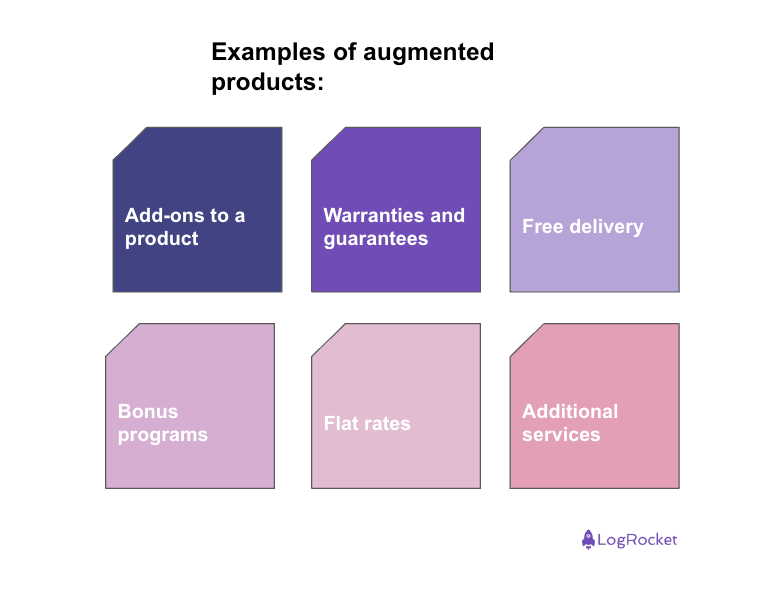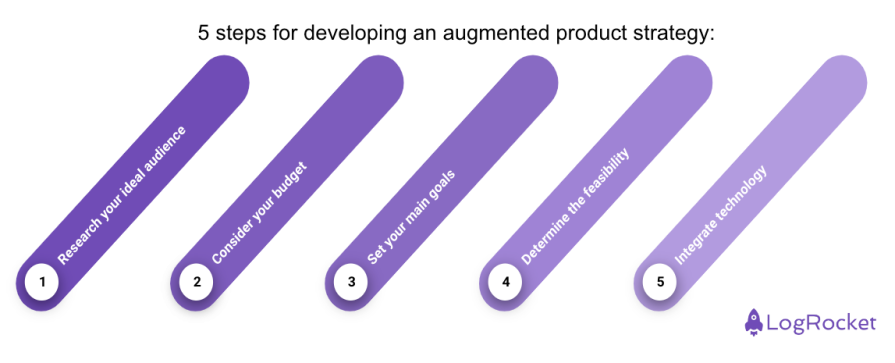Given that you have children, would you rather buy a breakfast cereal with toys included or one without? Putting aside all the climate concerns. If you’re standing in a store and have two equally good electric shavers in front of you, only one of which has a free three year guarantee, which one do you choose?

If you have the choice between a simple product and a product that provides some add-ons, you will, of course, choose the second one, even if you don’t immediately need the add-on. These add-ons and extras turn a product into an augmented product.
In this article, you’ll learn more about what an augmented product is, how to develop an augmented product strategy, and some of the challenges that accompany its implementation.
The world is complex and is becoming more and more competitive. This situation makes it increasingly difficult for product managers and marketers to place their products on the market in such a way that they can hold their ground against the competition’s products. To convince buyers to purchase your product it’s increasingly necessary to offer additional extras and add-ons and thereby secure the company’s edge over the competition.
Especially with digital products and SaaS solutions, you often see at least three different versions of the product on offer:
The idea behind an augmented product is that it doesn’t replace the actual standard product, but rather increases the value for the customer. This allows companies to create additional value for customers without having to expand the product itself. Ideally, this also means that the costs for product development aren’t increased and product development resources aren’t additionally impacted.
Although there are many different types of benefits and ways to create an augmented product, there are some well-known examples of augmentation. Here are some of them:

Add-ons can be both virtual and physical. They can offer additional functions and applications, e.g., a cereal box can contain a QR code that leads to a game. Another example would be a free laptop bag you get when buying a new laptop.
Many products come with extended warranties. These extended warranties don’t have a direct influence on the design and production costs of the product, but serve the customer’s need for more security and trust in a product.
Various e-commerce sellers are offering free delivery to appeal to customers. This influences the purchase behavior of customers and leads to more consumption because free shipping is often only included when you buy a certain amount.
When it comes to flying, airlines are in a highly competitive relationship with each other. Having loyal customers is very important. For this reason, many airlines offer bonus programs to retain customers.
In addition to prepaid services, telecommunications providers also offer free value-added services. Customers who subscribe to high-priced subscriptions for example are offered free data flat rates.
When it comes to credit cards, the different services are very similar and the perceived benefits for the customers are indistinguishable. That’s why the different credit card services have to differentiate from each other. Banks therefore often provide free travel insurance for holders of credit cards. Product augmentation is here key to success.
Product augmentation is tricky. On the one hand, it’ll help your customers to make a purchase decision in your favor. On the other hand, you have to be very careful about what you provide. You don’t want to increase your cost much, and you don’t want to add additional work or dependencies to your product development and product production. But when it’s done right, augmented products can significantly increase your product’s success on the market.
Augmented products provide increased customer loyalty. They can keep existing clients by providing value through bonus programs and additional services.
Often products are very similar to each other. With product augmentation, you can get an advantage with your product over the market competitors. Customers love additional services and added value for their money.
A common example of additional services to differentiate yourself from the competition is free-of-charge installation. You can buy washing machines at supermarkets and warehouse stores as well as retail stores. A retail store can offer free installation of the washing machine to attract customers.
With product augmentation, you can offer customers an even better user experience without having to augment the actual product. For example, visiting a beauty salon that offers snacks and drinks may be more enjoyable for the customer than visiting a salon without these benefits.
By offering this additional service, the salon wants them to recommend it to friends and family.
Another example of a better user experience through augmented products is additional content. As a laser cutter manufacturer, you can add value and create a better user experience by making a database of patterns and graphics available to your users. This will enable the users to start cutting patterns right away.
By introducing additional benefits such as extended warranties, a company can also strengthen its brand. Companies like Leatherman offer a 25-year warranty, demonstrating how durable and good its multitools are. This creates trust in the brand.
Some things make the lives of customers uncomfortable. A company can use these constraints to its advantage by augmenting the product or service to decrease these uncomfortable situations.
One-day shipping or overnight shipping are such examples. It’s unpleasant to wait for your online purchases. By offering fast shipment, you can reduce this feeling and stand out against your competition. Another example could be a waiting room at a clinic. Waiting in the waiting room can be uncomfortable. To ease that pain the clinic could offer some entertainment, video games, or other activities.
By offering augmented products you might make a big difference in comparison with your competitors. This can lead to increased demand for your product since your customers might recommend the product to their friends and family members.
Implementing a strategy to create augmented products requires a comprehensive approach that includes the whole organization. From marketing and creating an understanding of the market to leveraging technology and fostering collaboration, you have to work with different departments and roles:

Before you start designing your augmented products, you should have a good understanding of the market, your customers, and the target groups you want to address. You need to conduct research and identify the ideal target groups. Market research is about finding out what the target group wants most. With this information, you can determine what benefits your customers expect from your product.
Product augmentation is often budgeted through a company’s marketing budget. This makes sense as you don’t want to cut the budget of your product development teams. Depending on your budget for product enhancements, you can supplement your product with services that don’t cost you any extra money. For example, you can offer a free extended warranty. If you have the budget, you can add additional services or additional features or add-ons.
You can pursue various goals with product augmentation. For example, you can try to improve customer loyalty, or you can try to attract new customers and create a differentiator for your product.
After the Research and ideation phase, you might have several ideas to improve your products with product augmentation. At this point, it’s important to verify that you have the proper resources to implement them and that they’re worth it. For example, if you provide free premium support, you should first check if you have enough trained staff members to handle the increased workload.
Technology can help you to enhance your products with additional features, services, and user experience. This ranges from improving production lines over increasing your shipping capacity to digital products and data analytics.
For example, an improved production line can help you create customized products, like Coca-Cola did when it provided an interface that allowed you to customize the label on your bottle. But you can also improve the user experience by providing videos and digital content that help users better set up and use your products. To take advantage of these technology-based product enhancements, you need to be careful not to disrupt actual production or product development.
Ranging from technological constraints to resource conflicts, designing and creating augmented products comes with a couple of challenges. However, you can overcome these challenges by managing these risks properly.
Product augmentation aims to increase sales and gain an advantage over the competition by offering the consumer something extra. However, these extras come at the price of consuming resources. This is why it’s important to avoid resource conflicts when creating enhanced products.
After all, there’s no point in developing an augmented product feature when the product cannot be developed further. You shouldn’t block the development team from implementing features to augment the product.
Another challenge lies in the implementation of product augmentation with new technologies or other technical restrictions. It’s often difficult for organizations to introduce new technologies. Suddenly you have to deal with software lifecycles, software developers, and hosting.
For example, it could be a huge challenge to host and release a video game with every sold cereal box because the cereal manufacturer suddenly has to worry about IT infrastructure, maintaining apps, and so on. This can put a lot of stress on an organization.
To address these challenges proactively, it’s necessary to invest in strategic partnerships early on and to bring new talents into the organization by recruiting and building up teams.
However, building and reforming the organization leads to other problems like resistance to change and additional costs.
Whether internal stakeholders, the management, or even the customers, resistance can arise everywhere when implementing augmented products with new technologies or introducing new services.
Resistance to change is a major challenge. When new teams are set up, processes in production or delivery change, or simply more effort is required in support or customer success management you often end up in change management projects. If change management is carried out well, this resistance can be recognized and reduced. It’s possible to work on the culture and the courage to accept the new challenges and thus gain an edge over the competition.
Developing and shipping augmented products often increase the costs significantly. On the other hand, you also expect the revenue to grow. To determine if this investment is worth it, you can use cost-benefit analysis or rank your measures with the ICE scoring technique.
If executed well, you develop your augmented products in increments and develop MVPs. This’ll limit your committed resources to a minimum and give you a couple of checkpoints until you execute a big rollout.
Consumer expectations will continue to rise, influencing how you market your products. With product augmentation, companies have a strategy to better adapt their products to the market and gain an advantage over their competitors.
You can use product augmentation to attract new customers, but more importantly to retain customers and maximize the impact on the customer’s user experience. Although you may face some challenges when launching augmented products, the benefits will outweigh them in the long run.
Featured image source: IconScout

LogRocket identifies friction points in the user experience so you can make informed decisions about product and design changes that must happen to hit your goals.
With LogRocket, you can understand the scope of the issues affecting your product and prioritize the changes that need to be made. LogRocket simplifies workflows by allowing Engineering, Product, UX, and Design teams to work from the same data as you, eliminating any confusion about what needs to be done.
Get your teams on the same page — try LogRocket today.

A practical framework for PMs to use AI in ideation without sacrificing judgment, strategy, or decision quality.

A practical five minute revenue estimation method to help product managers compare ideas, drop low impact features, and prioritize smarter.

A practical guide for PMs who want to stop being bottlenecks, delegate smarter, and lead teams effectively with a clear ownership framework.

Stop letting unreliable data block features. Treat data as inventory to track quality, ownership, and ship with confidence.